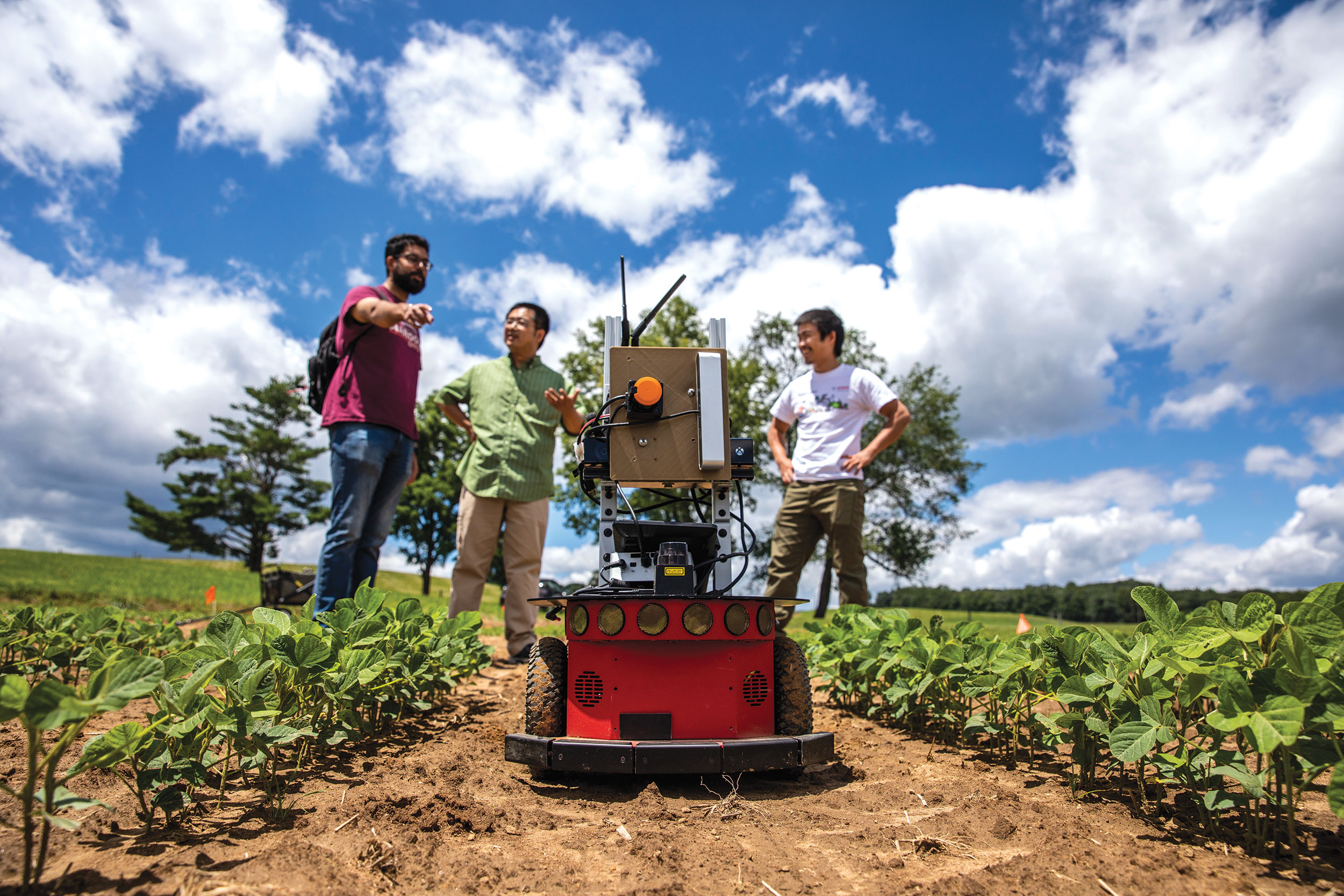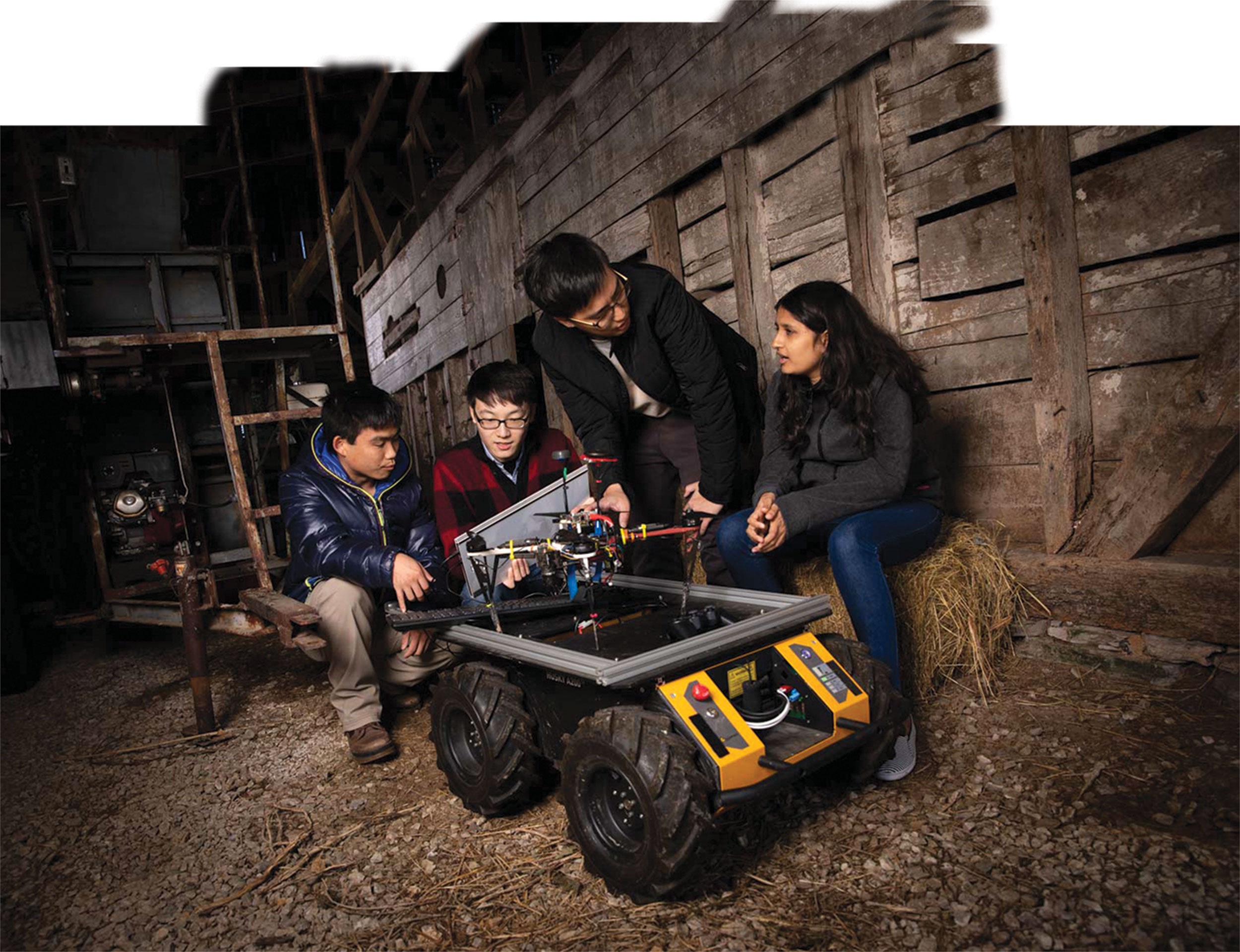TOOLS OF THE TRADE: Ph.D. candidates Kevin Yu and Yoonchang Sung work with senior undergraduate Tianshu Xu and master of science student Deeksha Dixit on the aerial and ground vehicles designed to autonomously monitor agricultural land.
Wouldn’t it be great if robots could handle the most monotonous or physically demanding tasks in the workplace?
That’s often the aim of the precision technology being developed at Virginia Tech for farmers. Utilizing robotic systems to autonomously tackle arduous agricultural tasks can, theoretically, free farmers to move on to other duties and, in many cases, greatly increase productivity.
It’s part of the same vision that was behind Virginia Tech becoming the first university east of the Mississippi River to provide an agricultural engineering curriculum in 1920, and it’s the concept behind many futuristic projects today.
“We are not designing robotic systems to do the job of the farmers,” said Alex Leonessa, a professor in Virginia Tech’s College of Engineering. “What we are trying to do is make the job easier for the farmers.”
AgBOT, a student team advised by Leonessa, leaned on this concept to develop robots that won first place awards in the national agricultural competition, the agBOT Challenge, in back-to-back years.
In 2018, Virginia Tech’s agBOT team took the top prize by designing an autonomous harvester that rolls through a watermelon patch identifying melons, picking them up, slapping them to tell if they’re ripe, then harvesting them. This year, the team upgraded the autonomous ATV they used in 2018 by adding obstacle avoidance technology and a self-contained laboratory. As a result, the team took first place in the contest aimed at collecting, storing, and preparing soil samples for analysis.
Assisted harvesting is also a feature of the Department of Mechanical Engineering’s autonomous grape-harvester, which can delicately pick table grapes. These grapes are so delicate they must be individually wrapped in paper to prevent overexposure to the sun.
Compounding the problems, the grapes’ ripeness is difficult to discern for the human eye. Using cameras and computer vision algorithms, the robot can detect accurately when grapes are ripe, and human pickers can direct the robot to harvest.
Alleviating the farmer’s workload is also central to the work of Pratap Tokekar, assistant professor of electrical and computer engineering. Tokekar, an expert in the realm of collaborative autonomous vehicles, is building a combination drone and ground vehicle system that can monitor and help control the height of vegetation—crucial for plant and soil health.

Researchers are designing robot pickers to help with physically demanding tasks in the farm field.
The drone scours the field, collecting data on plant height using on-board cameras and landing as needed on the ground vehicle to recharge its battery.
Autonomous advancements have been extremely helpful in the soybean research of Song Li, a Virginia Tech assistant professor of Department of Plant and Environmental Sciences. Working in partnership with the College of Engineering (to be specific, the Department of Electronic and Computer Engineering), Li is using autonomous robots that can move through crops and drones that hover above the field to measure plant height and canopy coverage. The data collected will be used for selecting better varieties for breeding and for identifying genetic markers associated with desired traits.
“Traditionally, people would use measuring sticks and hand-held cameras to measure these traits. Walking the whole field and taking measurements of hundreds of plots are very labor intensive, and the measurement is sometimes biased because each person may have a different way to measure the traits of interest,” Li said.
Li is working with Assistant Professor Bo Zhang to use this technology to identify a variety of edamame that could be successfully grown in Virginia. Once it’s found, Virginia farmers can reap the benefits of tapping into a market that is currently dominated by imports from Asia.
The examples of autonomous machines in farm life are boundless, and that makes sense, said Tokekar, because the challenge posed by agriculture is a perfect match for engineers seeking to bring helpful technology to the fields.
“Agriculture has always been a very natural partner for robotics research because farms are not completely unstructured, like driving on the roads and so on. But they are not so structured that it's trivial from the robotics point of view,” Tokekar said. “The semistructured nature of these farms gave a good opportunity for people to actually go and deploy robots in the real world.”
